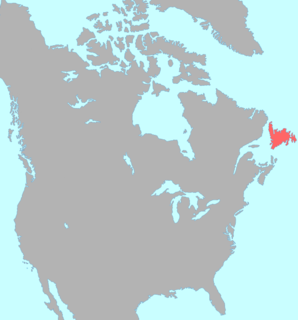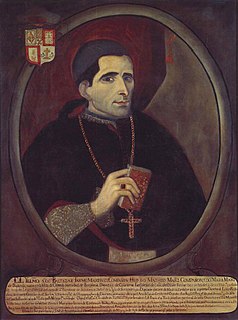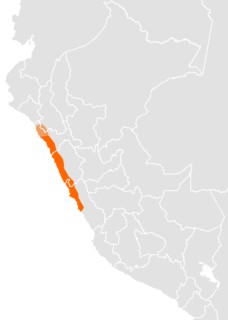Related Research Articles

Beothuk, also called Beothukan, is an extinct language once spoken by the indigenous Beothuk people of Newfoundland. The Beothuk have been extinct since 1829, and there are few written accounts of their language. Hence, little is known about it, with practically no structural data existing for Beothuk.

The Choco languages are a small family of Native American languages spread across Colombia and Panama.

This is a list of different language classification proposals developed for the indigenous languages of the Americas. The article is divided into North, Central, and South America sections; however, the classifications do not correspond to these divisions.

Mochica is an extinct language formerly spoken along the northwest coast of Peru and in an inland village. First documented in 1607, the language was widely spoken in the area during the 17th century and the early 18th century. By the late 19th century, the language was dying out and spoken only by a few people in the village of Etén, in Chiclayo. It died out as a spoken language around 1920, but certain words and phrases continued to be used until the 1960s.
The Peba–Yaguan language family is located in the northwestern Amazon, but today Yagua is the only remaining spoken language of the family.

The Borôroan languages of Brazil are Borôro and the extinct Umotína and Otuke. They are sometimes considered to form part of the proposed Macro-Jê language family, though this has been disputed.

Cabredo is a Spanish village located in the west of Navarre near the border with Álava, 79 kilometres (49 mi) away from Pamplona, capital of the region. In 2012 it had a total population of 109 inhabitants. It is located below the Codes mountain range and crossed by the Ega river.

Zaparoan is an endangered language family of Peru and Ecuador with fewer than 100 speakers. Zaparoan speakers seem to have been very numerous before the arrival of the Europeans. However, their groups have been decimated by imported diseases and warfare, and only a handful of them have survived.
Chimuan or Yuncan is a hypothetical small extinct language family of northern Peru and Ecuador.

The Catacaoan languages are an extinct family of three languages spoken in the Piura Region of Peru. The three languages in the family are:

Culle, also spelled Culli, Cullí, or Kulyi, is a poorly attested extinct language of the Andean highlands of northern Peru. It is the original language of the highlands of La Libertad Region, the south of the Cajamarca Region (Cajabamba), and the north of the Ancash region. It is known through various word lists collected while the language was still spoken and through vocabulary loaned into the Spanish spoken in the region.
The extinct Hibito–Cholón or Cholónan languages form a proposed language family that links two languages of Peru, Hibito and Cholón, extinct as of 2000. They may also be related to the extinct Culle language, and perhaps to the language of the Chachapoya, but the data for all of these languages is poor.

Sechura–Catacao is a proposed connection between the small Catacaoan language family of Peru and the language isolate Sechura (Sek). The languages are extremely poorly known, but Kaufman (1990) finds the connection convincing, Campbell (2012) persuasive.
Tequiraca (Tekiráka), also known as Abishira (Avishiri)* and Aiwa (Aewa) and Ixignor, is a language spoken in Peru. In 1925 there were between 50 and 80 speakers in Puerto Elvira on Lake Vacacocha. It is presumed extinct some time in the mid 20th century, though in 2008 two rememberers were found and 160 words and short sentences were recorded.
The extinct Palta language of the Ecuadorian Amazon is attested by only a few words: yumé 'water', xeme 'maize', capal 'fire', let 'wood', and some toponyms. Based on this, Jacinto Jijón y Caamaño (1936) classified it as a Jivaroan language. Kaufman (1994) states that there is "little resemblance", but Adelaar (2004) finds the connection reasonable. In addition to these four words are toponyms, which commonly end in -anga, -numa, -namá. The latter two suggest the Jivaroan locative case suffix -num ~ -nam, and Torero (1993) notes that the last resembles Aguaruna (Jivaroan) namák(a) 'river' as well.
Tallán, or Atalán, is an extinct and poorly attested language of the Piura Region of Peru. It is too poorly known to be definitively classified. See Sek languages for a possible connection to neighboring Sechura.

The Marañón River basin, at a low point in the Andes which made it an attractive location for trade between the Inca Empire and the Amazon basin, once harbored numerous languages which have been poorly attested or not attested at all. Those of the middle reaches of the river, above the Amazon basin, were replaced in historical times by Aguaruna, a Jivaroan language from the Amazon which is still spoken there. The languages further upriver are difficult to identify, due to lack of data. The region was multilingual at the time of the Conquest, and the people largely switched to Spanish rather than to Quechua, though Quechua also expanded during Colonial times.

Baltasar Jaime Martínez Compañón was a Spanish prelate who served as Bishop of Trujillo, Peru, Peru from 1779 to 1790, at Trujillo Cathedral, and Archbishop of Bogotá, New Granada, from 1790 to 1797. He was responsible for founding new towns, building schools, and reforming the silver mine at Hualgayoc. He is most remarkable for his efforts to educate Trujillo's Indians and for his research into local plants, animals, archaeological ruins, music, and native cultures.

The Codex Martínez Compañón (c.1782–1785), is a manuscript edited in nine volumes by the bishop of Trujillo, Peru, made by Baltasar Jaime Martínez Compañón, containing 1,411 watercolours and 20 musical scores documenting life in his diocese. This work was sent to Charles IV of Spain, who included it in the Royal Library in 1803. The musical examples in the bishop's text were probably written out by Pedro José Solis, maestro de capilla of Trujillo Cathedral from 1781 to 1823.

The Quingnam language was a pre-Columbian language that was spoken by the Chimú people, who lived in the former territories of the Mochicas: an area north of the Chicama Chao River Valley. At the height of Chimú conquests, the language was spoken extensively from the Jequetepeque River in the north, to the Carabayllo in the south.
References
| Wiktionary has word lists at Appendix:Sechura word lists |
- 1 2 Adelaar, Willem F. H.; Pieter C. Muysken (2004). The Languages of the Andes. Cambridge: Cambridge University Press. pp. 398–401. ISBN 0-521-36275-X.
- ↑ Campbell, Lyle. 2018. Language Isolates. New York: Routledge.
- 1 2 Martínez Compañón, Baltasar Jaime. 1985 [1782-1790]. Trujillo del Perú en el siglo XVIII, vol. 2. Madrid: Ediciones Cultura Hispánica.
- ↑ Kaufman, Terrence (1990). "Language history in South America: What we know and how to know more". In Payne, D.L. (ed.). Amazonian linguistics: Studies in lowland South American languages. Austin: University of Texas Press. pp. 13–67. ISBN 0-292-70414-3.
- ↑ Rivet, Paul (1949). "Les langues de l'ancien diocèse de Trujillo". Journal de la Société des Américanistes de Paris (in French). Paris. 38: 1–51.
- ↑ Torero Fernández de Córdova, Alfredo A. (1986). "Deslindes lingüísticos en la costa norte peruana". Revista Andina (in Spanish). Cuzco: Centro Bartolomé de Las Casas. 4: 523–48.
- ↑ Urban, Matthias. 2019. Lost languages of the Peruvian North Coast . Estudios Indiana 12. Berlin: Ibero-Amerikanisches Institut (Preußischer Kulturbesitz) & Gebr. Mann Verlag.
- ↑ Urban, Matthias (2015). El vocabulario sechurano de Richard Spruce. Lexis Vol. 39(2): 395-413.